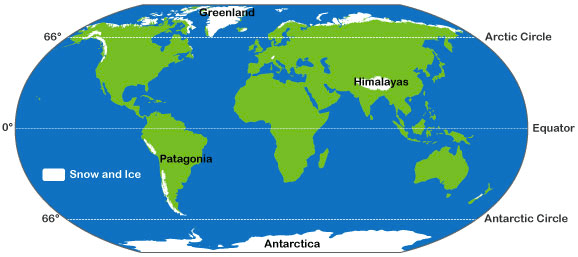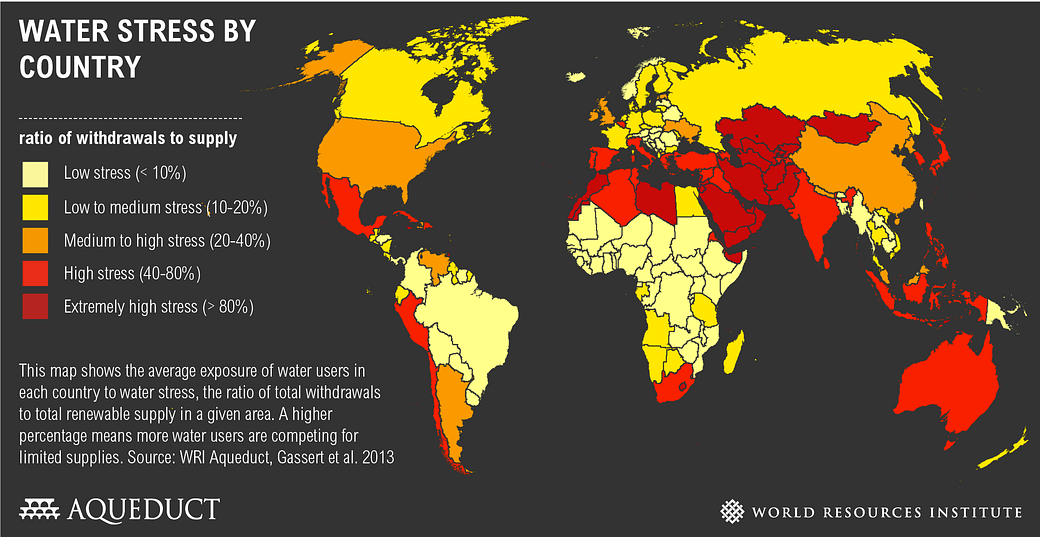With the global climate becoming increasingly unpredictable, it is likely that water could become our most precious commodity not far in the future. Global warming is accelerating the melting of glacial reservoirs and snowpacks all around the world, and impacting the perennial rivers that flow out of them (Image1 and 2). Almost 1.3 billion people depend on the glacially-fed rivers from the Himalayas that are at risk of disappearing in the summer seasons. Countries have traditionally responded to water stress by either creating huge dams to hold back freely flowing surface water or turning to desalination from the ocean.

Image 1: Glaciers of the world (Reproduced with the permission of the British Geological Survey ©NERC. All rights Reserved)

Image 2 reproduced with kind permission from WRI.
Dams are not only resource and land intensive, but also submerge huge swaths of land behind them. Their construction has most often required displacement of many villages or tribal areas in highly populated countries like China and India. Desalination plants, on the other hand, are expensive to build and leave the concentrated brine as a byproduct that needs to be properly disposed of. Water purification at a scale that nature achieves would undoubtedly require trillions of dollars worth of investment (Image 3). It is estimated that the total amount of rainfall on the surface of earth equals 27*1015 gallons of fresh water per year. Imagine desalinating even 0.0001% of that. World’s largest desalination plant, Ras Al Khair Desalination plant in Saudi Arabia cost approximately $7.2 billion to build which has a capacity to desalinate 228 million gallons of fresh water per day (Image 3).

Image 3: Quadrillions of gallons of fresh water rain down on earth at no cost to us, while desalinating a fraction of that requires infrastructure that costs billions of dollars. (Costs compared to the world’s biggest desalination plant in Saudi Arabia with a capacity of desalinating 228 million gallons a day)
Civilizations have flourished and died at the mercy of water resources and increasingly the world seems to be losing its grip over the efficient management of this resource. The UN estimates that approximately 2.8 billion people deal with some sort of water stress in their day-to-day lives, with over 1.2 billion of them without direct access to this resource (Image 2). These numbers are only poised to grow.
Over thousands of years of human civilization, water circulation via the weather patterns has provided a very reliable source of water. Sun’s energy provides the fuel for evaporation; low-pressures inland draw in the moisture filled clouds from the oceans, drenching the open land. As these moisture filled clouds encounter a mountainous terrain, they rise along the barrier and the cooler temperature at higher elevations causes precipitation creating snowfall (Image 4). This snowfall accumulates into a reservoir of ice or into glaciers that slowly thaw and release water into perennial rivers throughout the year including the summer season. The colder temperature in the higher elevations of the mountains prevents snowmelt until summer seasons. But global warming will change all of that.

Image 4: Cycle of water
Effects of climate change and global warming on water resources
- Erratic weather patterns, with increased incidences of floods and/or prolonged droughts.
- As the CO2 levels rise, the global average temperatures will continue to rise, accelerating the melting of the snow packs and glaciers in the upper mountainous regions in spring itself. This will likely eliminate the snowcaps with minimal storage left for summer seasons.
- Rapid melting of snowcaps will cause flooding in spring with no surface water left in summer.
- Increased evaporation from existing surface water resources, decreasing the water levels in the reservoirs.
- Dwindle of the already stressed resources of groundwater reserves across the world without giving them a chance to replenish.
There is an urgent need for innovations that can guarantee the future supply of water resource across the world.
We asked ourselves on how could we design a solution that maximizes the impact with minimal cost?
Optimal solution considerations:
Constraints that were considered while developing a solution –
- Inexpensive infrastructure to build with high return on investment
- A resource that could survive the warming global climate
- Minimal usage of under use land (occupied by any flora or fauna).
- Minimizing the need for displacement and resettlement of existing dwellers of the land
Note: Increasing the number of water-storing dams would not work, as land resources are limited in highly populated countries.
Proposed solution: “Snow-Dams” on mountain peaks/higher elevations
Mountain geoengineering could act as an excellent solution to buffer water supply downstream. This would work by holding more snow in the uppermost reaches of the mountain ranges (i.e. peaks) where temperatures are still cold. As the snow falls on the almost vertical mountain peaks, the snow, unable to stay on top of the summit, inadvertently slides down into the lower reaches of the mountain, where it is susceptible to thawing into snow melt in spring (much earlier than summer). We could change that! As the global temperatures rise, the snowfall in the lower elevations of the mountains would not survive the heating atmosphere and would likely thaw as soon as it lands. Hence, it is important to develop “snow-dams” that could hold the snow on the uppermost elevations (Image 5). Uppermost elevations will be naturally colder than regions below them and could prevent the snow from immediately melting until the summer months.
We propose that an artificial series of barriers be built on the peaks/higher elevations of the mountains to hold snow as it lands on the peaks.

Image 5: Proposed snowdams would stock the snow high up in the elevations, away from any habitation, preventing their rapid melt in a warming climate. Image source: Snow covered mountain peak (Arakam Tse – 6423m) high in the Himalayas of Nepal. (Image copyrighted from 123rf.com)
Making reservoirs on elevations could help with easy design and selection of locations to develop these reservoirs with colder temperatures. In addition, these higher elevations are almost always uninhabited by any kind of flora and fauna and thus would not require any relocation. This idea could become an important asset in the fight to hold more surface water in the mountainous regions with minimal population displacement.
Detailed case study: Mount Everest
Let us assume that we magically build a snowdam (10-meter high wall) on the top 500 meters of the Mount Everest as shown in the figure on the left.
For the sake of this case study, let’s assume the following numbers:

- Approximate total radius of Mount Everest = 10 miles (16 km)
- Total height (Elevation) = 8,848 m
- Let’s assume we construct the snowdam in the top 500 meters of the mountain peak with the cone radius of 1000 meters.
The volume of the snow pack can be calculated as following:
Vsnowpack = V(mountain+snow) – V(mountain)
Vsnowpack = (π*r12*(h1)/3) – (π*r22*(h2)/3)
Vsnowpack = 10519000 m3
10-meter dam height, covering the top 0.5 km of this mountain could hold over 10 million m3 of fresh snow which if converted to ice at an 1:1 basis could yield over 2 billion gallons of fresh water.
Of course, one could argue that the freshly fallen snow is hardly dense. Fresh snow is fluffy with an approximate density of 1/20th of water (50 kg/m3) due to the air trapped in it. But Sorge’s law tells us that with repeated snowfalls, the bottom most layer of snow will slowly compact into ice under the heavy weight, rapidly increasing its capacity. In addition, the machinery on the top could also actively condense the snow into ice for future usage. These barriers could also be temperature regulated to discharge water as desired for consumption in lower elevations.
Overcoming the construction challenges:
The collision of Indian plate into Asian tectonic plate led to the formation of the Himalayas. The peaks were lifted off from the base of the ocean and form the limestone rich sedimentary layer of the mountain peaks. Limestone poses a major construction challenge, as it cannot bear the heavy weight of the structures built on it. In addition, any construction at the peak/higher elevations could lack the strong foundation that is essential for any structure.

Image 6: Snowfall is directed towards the base of a coniferous tree via uniquely directed branches that relieve the weight from the upper portion of the tree. Arrows point to the alignment of the branches. (Note: No copyright infringement intended)
To overcome this challenge, we propose learning from the Christmas tree or any other coniferous tree for that matter. A Christmas tree standing tall in a snowy day faces a similar problem of snow and weight. The snow that falls on the topmost leaves if accumulated could break the susceptible weaker twigs. Hence, the ingenious solution that the tree has come up with is to direct the snow from the top reaches of the tree to the bottom portion. The angular structures of the tree branches guide the snow to the base where the branches are older and stronger (Image 6). This keeps the top part of the tree free of any snow accumulation.



Image 7: Series of barriers direct snow to the base where reinforced walls can hold the weight of the snow/ice. Barriers towards the peak are smaller whereas lower ones are taller and wider. (Designs a., b. and c. 3D rendering)
We propose a similar design of barriers that direct the snow to the lower reaches of the peak where the base could be reinforced with a thicker barrier and a deeper foundation (Image 7). The face of a mountain is hardly plain and smooth that most of the constructions require. Hence, it is most likely that pillars that are connected by nets/meshes/fences in certain situations will replace a continuous wall. Wall height could be reduced if necessary to guarantee the safety of the proposed structure and prevent avalanches (series of 1-meter high barriers could still hold 275 million gallons/peak (case study)). In addition, the color white could be chosen to reflect most of the sunlight and prevent unwanted heating of the snow. A system such as this would be useful in other parts of the world looking to boost their snow packs. They could be useful in places such as California (Sierra Nevada mountains), the Alps where early spring melt is a challenge in a warming climate.
As our climate warms, there needs to be dialogue, debate and discussion as to how could we keep the future water supply intact for an ever-changing world. Thankfully some rules of physics and engineering will not change as fast as our climate might.
References
- Peixoto, J.P. and M.A. Kettani. “The Control of the Water Cycle.” Scientific American. Vol. 228, No. 4 (April 1973): 46-61.
- http://www.water-technology.net/projects/-ras-al-khair-desalination-plant/
- http://www.independent.co.uk/news/science/lack-of-fresh-water-could-hit-half-the-world-s-population-by-2050-8631613.html
- http://www.un.org/waterforlifedecade/scarcity.shtml
- http://beyondpenguins.ehe.osu.edu/issue/icebergs-and-glaciers/glaciers-earths-rivers-of-ice
- http://en.allexperts.com/q/Geography-1729/Volume-Mount-Everest.htm
- http://blog.environmentalresearchweb.org/2009/12/07/sorges-law-the-conversion-of-s/
- http://www.bgs.ac.uk/discoveringGeology/geologyOfBritain/iceAge/home.html
- http://www.wri.org/resources/charts-graphs/water-stress-country
- http://www.reuters.com/article/us-china-threegorges-idUSBRE87L0ZW20120822
- https://www.culturalsurvival.org/publications/cultural-survival-quarterly/displacement-and-development-construction-sardar-dam
- http://bioweb.uwlax.edu/bio203/2010/panich_just/Site/Adaptations.html
Copyright – The work above is the original work of the author and may not be replicated without permission.
Hi pavan, nice article.. I would recommend that you can also look into the details of at what rate the population and water demand is growing and to what extent these snow dams can cater to it… especially considering the fact also about the sensitivity of mountain beds to hold concrete constructions…